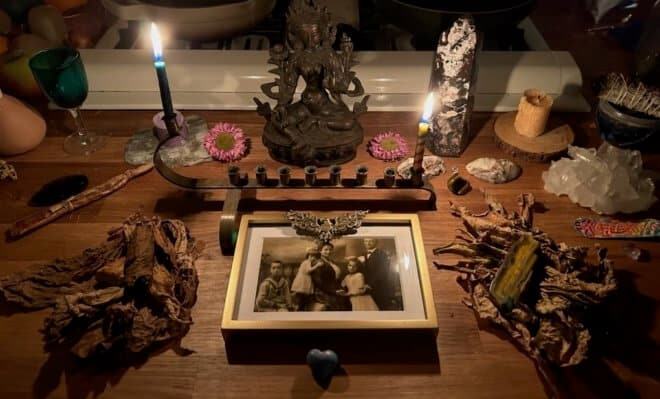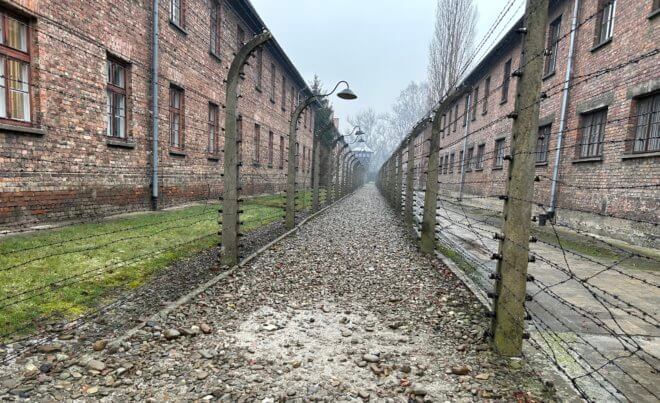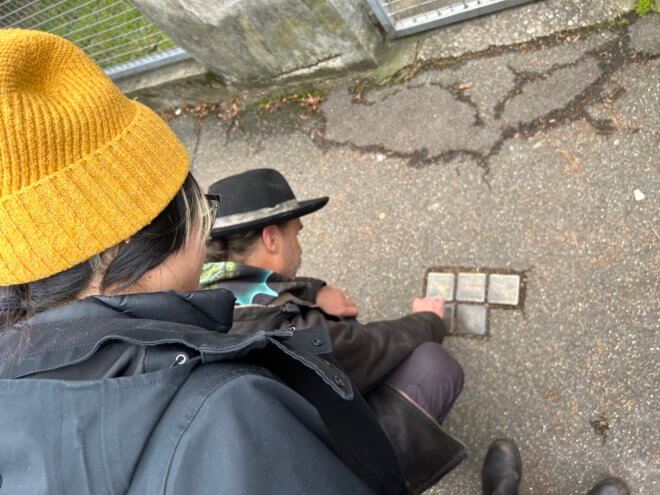Holocaust Remembrance Day, January 27, 2023
A few months ago, our good friend and Dr. Bronner’s Director of Social Action Adam Eidinger invited me, my wife Mia Bronner, my 25-year-old kid Maya Lin-Bronner, and our friends Ariel Vegosen and Kris Furnish, to accompany him and his eighteen-year-old daughter Arundhati to visit Auschwitz in Poland. Set up about sixty miles outside of Krakow, Auschwitz was the Nazi’s largest extermination camp, where 1.1 million Jews were murdered along with 200,000 others, including political enemies, Roma, LBGTQ people and others the Nazis deemed “undesirables.” Among the victims was my great-grandmother Franziska Heilbronner, mother of my grandfather Dr. Emanuel Bronner. She was killed in 1944, after her husband—my great-grandfather Berthold Heilbronner—had already perished in Theresienstadt two years earlier.

Auschwitz housed up to 130,000 people at a time in sprawling, overcrowded, disease-ridden barracks. Upon arrival by train on brutally overcrowded cattle cars, victims went through a selection process: those deemed too old, young or sick to work were immediately directed towards and murdered in the gas chambers (approximately three-quarters of all arrivals). Those deemed able to work lived in subhuman conditions in the barracks, and generally their lifespan averaged just a few months until they were too weak and were likewise killed. The gas chambers were represented as “showers” and victims right off the train were not aware of their fate until the poisonous Zyklon B was dropped from above and they suffocated and died in agony over the course of their last 20 minutes.
On our visit, our group walked in the snow the half mile from where Franziska and other victims were dropped off and “selected” to their doom in the gas chambers and crematorium. We saw the ruins of the gas chambers that the SS (the Nazi paramilitary units that ran the camps) had blown up to try and cover their crimes, and we walked through the first of the fully operational gas chambers, where up to 2,000 victims were killed at a time. We listened to stories of how the SS would not try and separate babies from their mothers, given how disruptive it would be, and would just assign both to be killed immediately. This is why upon arrival young mothers were advised by desperate inmates without explanation to give their babies to elderly grandparents, who were guaranteed to be killed immediately regardless, giving the young mothers some chance of surviving the horrors after selection.
It was all horrible beyond comprehension that no words can adequately convey. My great aunt Luise Bronner wrote this poem in Hebrew, German, and English:
May I Never Forget
(In memory of my parents who died in concentration camps; April 1961)
May I never forget
that their life was cut off
by those who do not know
the source of all light.
May I never forget…
when I see wrong done
by those who judge
and are not called upon to judge.
May I never forget…
when I see someone hurt
by those who can not see
And by those who can not hear.
May I never forget
that their light was cut off,
but still burns in me,
trying to understand, trying to see.
After visiting Auschwitz and spending time in Kazimierz, the Jewish quarter of Krakow, visiting sites of Jewish and Polish life such as the synagogues and the salt mines there, we flew to Germany to visit our ancestral homes in Laupheim and Heilbronn. Dr. Bronner’s grandfather Emanuel Heilbronner, my great-great-grandfather, first began making soap in the basement of the Laupheim house in 1858. Three of his sons, Berthold, Karl and Sigmund, moved back to Heilbronn and established a new much bigger factory at the turn of the century, that supplied much of the liquid soap used in Germany by the 1920s and ‘30s.
However this time also saw the rise of various right wing parties in Germany, including the National Socialist Workers Party or Nazis, that scapegoated the German defeat in WWI on the relatively miniscule Jewish population, who supposedly had undermined the German war effort despite serving in the German army at higher rates than non-Jews, with monuments proudly commemorating veterans in Jewish cemeteries across the land. Part of the enormous tragedy of my family in Germany, and of German Jews in general, is that they were fully integrated in German life, having a majority of non-Jewish friends and colleagues, and they identified very much as Germans.

The Nazis came to power in 1933 and began their systematic program to rid German society of Jews, at first gradually, but then accelerating towards the “Final Solution” to murder the entire people. In 1940 our family soap factory in Heilbronn had been “Aryanized,” the Nazi term for forced sale of Jewish property to Nazi party members for a fraction of the value. In our case, the factory was sold for one Deutschmark. Berthold and Franziska were deported sometime after, initially to Theresienstadt, where Berthold died. Franziska was then deported to Auschwitz, where she was killed in 1944. Their children fortunately had already escaped. Dr. Bronner in 1929 to the U.S., my great-aunt Lotte in 1936 to the kibbutz Ein Gev in then Palestine now Israel, and my great-aunt Luise to the U.S. in 1938.
My family’s ancestors had been in the area possibly as far back as the Roman Era. An especially large wave of Jews migrated out of the Middle East fleeing the brutal Roman conquest of the first and second centuries. Some of them eventually settled in Central Europe. In Christian Europe of the Middle Ages, Jews were regularly persecuted because of their religion and their separateness as a community. They faced frequent harassment and deadly pogroms (organized massacres) wherever they settled, often expelled and forced to resettle elsewhere. Rulers would repeatedly confiscate Jewish property to enrich themselves. With the Enlightenment in the late 18th century things began to improve, and throughout the 19th century Jews gradually and unevenly were granted more equal rights under the law, and they began to flourish in different professions and trades, including soapmaking.
As of last year, my family purchased our ancestral home in Laupheim and are currently renovating it to serve as a home for adults with disabilities, managed by a Catholic charity, as well as to be an adjunct of the Christian Jewish museum in Laupheim which chronicles the history of Jewish people in the area. Its mailing address also serves for Dr. Bronner’s Europe. We also visited our ancestral home and factory in Heilbronn. The factory is now owned by the Frank family, a multi-generational manufacturer of high-tech metal parts. They purchased the factory from the illegitimate Nazi owner and weren’t involved in the forced sale.

I believe Laupheim and Heilbronn, like Germany generally, have done a relatively good job of reckoning with and taking responsibility for the past. My family received some level of reparations, and Germany is one of Israel’s largest supporters. This isn’t to say that large swaths of the German population aren’t still in some level of denial about the enormity of their collective crime and history, but generally speaking Germany is far ahead of America in owning their shameful history, in a way that we sadly have not done with our genocide of Native Americans and enslavement of Black people. When first visiting a Holocaust site in Cologne, Germany, fifteen years ago, I was impressed to see the local high school students visiting as well, downloading all the terror imposed by official German policy during the Nazi reign.
This contrasts with what I was taught about the genocide of Native Americans and enslavement of Black people. When I was growing up, my understanding was that the South (“way over there” in my mind) had enslaved Black Americans, and “we” had liberated them with the Civil War, and Martin Luther King Jr. took care of the rest. In a similar vein, my education on California history was that Father Junipero Serra in California had built a bunch of missions and helped educate “good” Christianized Indians about agriculture, and that the missions had to contend with regular attacks from “heathen” Indians. But generally Native Americans were invisible in this version of history, with the Gold Rush and Manifest Destiny front and center. I had no sense growing up that American settlers and the U.S. government had done anything bad to Native Americans, or any understanding of their incredible tribes and cultures, many that have been systematically destroyed and eradicated, their children forced into brutal boarding schools where they were forbidden to speak their language or practice their traditional spiritual ways.1
I had no sense that the Declaration of Independence and Constitution applied to a very narrow slice of wealthy, land-owning white men, while Blacks, Native Americans, the poor, and women were oppressed, exploited, and denied the rights those documents afforded a privileged few. I didn’t even learn about the systemic racism and redlining against Black Americans in Los Angeles and San Diego, my former and current hometowns until adulthood. Or that official California policy aided and abetted the massacre and displacement of Native Americans during the Gold Rush.
I don’t write this to diminish the enormity of Nazi crimes, and their scale, efficiency, scope and brutality leveraging modern technology; but rather to point out that the human capacity to dehumanize, scapegoat, and caricature the “other,” is not limited to one region or time of this Earth. The blood of the oppressor and oppressed flows through pretty much all of our veins, and at different historical moments in different configurations our ancestors both perpetrated and suffered oppression and persecution.2 All regions of the Earth throughout history have seen imperial expansion and oppression justified by one tribal way over others.3 Here at home, in the U.S., we are seeing a rise of neo-fascism, hate, and racism, including anti-Semitism and Holocaust denial, which is really depressing and concerning to see. The horror of the Holocaust deeply informed and fueled Dr. Bronner’s “All-One” passion to unite the human race across religious and ethnic divides, to promote peace, love, understanding, and respect. May we strive to always honor their sacrifice, and replace hate with love, intolerance with acceptance, and ignorance with respect and understanding.
It’s no small irony that during our visit, Germany was grappling with whether to support Ukraine with Leopard 2 tanks to defend against Putin’s aggression, overcoming their understandable reluctance and aversion to militarism given their recent history. But now like America was during World War II, is being called to send meaningful support to another nation in need, battling imperial expansion and fascist madness.
One more synchronicity I want to share, is that I was really feeling Berthold and Franziska while I was at the last Burning Man festival, where with a community of foamy homies, each year I help create a magical gift blasting foam to clean dusty burners. We are not present there as Dr. Bronner’s versus as the foamy homie support camp for the Zendo project, and our foam camp welcomes visitors into giant plexiglass showers and then ecstatically blast them clean, with my granddad’s soap through my dad Jim Bronner’s firefighting foam technology. Over the years, more than a few Jewish burners have associated the experience with the Holocaust and some found it deeply triggering. This year we placed a large chai, the Hebrew word for “life,” above the showers to hold and support any Jewish burners experiencing generational trauma and help them process through to the present celebratory moment.
I really felt and saw that what we’re doing out there is a deep symbolic answer to the Nazi terror, that violated my ancestors’ sacred bathing space to commit the most horrendous mass murders. Now, two generational octaves onwards in our foam camp at Burning Man, all races, creeds, and orientations are honored and united in ecstatic joy under foam.4 I’ve deeply felt the support of my Jewish family and ancestors, that they are dancing and living and loving through us. We have got to keep on charging! L’Chaim!! All-One!!!
________________________
Notes
1 I recently finished the excellent book “Mother Earth Spirituality: Native American Paths to Healing Ourselves and World” by Ed McGaa, Eagle Man. He was a Sioux spiritual leader, US combat veteran and Lakota champion in the fight to re-establish and rekindle traditional Lakota ceremonies and ways, that had been brutally suppressed by our dominant culture. His work is deeply informed by the legendary Sioux visionary Black Elk, and seeks to help not just indigenous but sincere non-natives in his “rainbow” vision to help all of us restore and reconnect with a deep Earth based spirituality via Lakota ceremonies, including the Sweat Lodge (Inipi), Vision Quest (Hanblechia) and Sun Dance.
2 My cousin Eric Bronner won an essay contest that Steven Spielberg sponsored as part of the collective processing and understanding provoked by his excellent dark account of the Holocaust via his movie Schindler’s List. Eric notes specifically that the blood of both the Jewish victims and Nazi perpetrators flows in his veins and is part of his complex identity in this world. He also calls on all Americans to dedicate their lives and resources to fighting injustice and righting the wrongs in our unequal society.
3 Noting too, with much qualification, the current ascendance of the Jewish right wing vision and policy of a “Greater Israel” that appropriates Palestinian lands and denies the legitimacy of Palestinian identity and right to shared ancestral land, as “Arab squatters” on the one hand; coupled on the other with virulent anti-Semitism in Palestinian and Arab culture that denies Israel’s right to exist on shared ancestral land inside its 1967 borders.
4In Ed McCaa, Eagle’s Man’s book referenced above, he briefly touches on the Ghost Dance ceremony, which led me to investigate further. The version I learned in school was that it was some kind of desperate hysterical pan-tribal reaction to the colonial decimation underway in the late 1800’s that freaked out US settlers and led to the massacre of the Lakota. On further deeper review, while definitely a reaction to the decimating horror of our colonizing conquest and oppression, seeking to rid their world of White colonizers through collective prayer, it was also a beautiful and powerful movement to acknowledge and purge the darkness in their own hearts and live in right relationship with each other. I had the vision of all communities and peoples of the Earth adopting, with permission, some culturally inflected form of the Ghost Dance in a global prayer and effort to purge our hearts and cultures of all forms of oppression, and found out that the visionary who started the movement was a Paiute named Wovoka who lived in their ancestral land in northern Nevada, on land that Burning Man takes place, with their permission and involvement over the years. While in part rightfully critiqued as a festival of superficial indulgence and excess of the privileged few, the burn is also about expressing and loving our ownmost soulful expressions and joy in each other, and is a very deep ceremony in itself. And the burn is taking real steps to diversify and this last burn had much more significant indigenous and BIPOC participation then ever before. And in our own camp’s psychedelic speaker series, Sutton King, founder and ED of the Urban Indigenous Collective and Program Manager of the Indigenous Medicine Conservation Fund, opened each day’s series with a land acknowledgement thanking the Paiute, noting the dilapidated infrastructure and collective trauma ricocheting down the generations that they like all other indigenous tribes of America are suffering and dealing with. She called on all of us to own and take responsibility for our history, and understand our relative privilege and power in this historical moment, as well as the debt the psychedelic movement owes to indigenous medicine traditions, and take the individual and collective steps necessary to restore, honor and make things right for all of us. Aho sister, may we live and burn ever more consciously!